Ant Control
Ants – The most common invader
Of all insects that infest buildings, ants are the most common. There are many different species of ant. Each is unique in terms of nesting sites, habits, characteristics and feeding preferences.
All ants live in colonies, consisting of:
- An egg-laying female (Queen)
- Short-lived males and workers (sterile female)
- Foragers in gardens or kitchens (Workers)
Workers are a nuisance. They forage widely in search of food and can damage food used for human consumption. In hospitals, the pharaoh ant feeds on blood, intravenous fluids and fluids associated with wounds and vomit. Materials can be damaged by ants chewing and some bite.
Identify the invader
Conduct surveys to determine the extent of the infestation and the ant species. Species identification is essential to determine the most effective bait.
Achieve long-term ant control
Successful, long-term ant control requires the destruction of the nest. This is often difficult to achieve as nests are typically located in inaccessible places.
Baiting will achieve the most effective control. Foraging ants feed on the bait and transfer the active ingredient back to the rest of the ant colony. Spraying can also be used to form a perimeter barrier treatment that ants don’t like to cross, effectively keeping ants outside the premises.
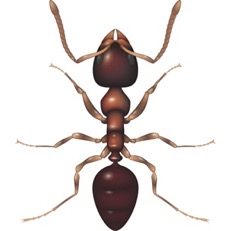
Black House Ant
Classification
Species category: Ant
Scientific name: Lasius niger
Family: Formicaide
Description
One of the most common species of ants across the world, different members of the colony will have a slightly different appearance. Workers are dark brown-black and reach 3-5mm in length. The queens are mid brown and much larger, they can reach 15mm long.
The queen is characterised by 2 pairs of wings which are fore and hind wings hooked together. Once mated, she removes the wings and eats them for nutrition over the winter months.
Widespread across Europe, North America and Australasia
Generally, nests are located outdoors; they can be built in soil, hollowed trees, found in grasses or under paving slabs, behind fascias or any building voids. Foraging workers enter houses regularly in search of food, preferably sweet foods.
Behaviour
Black ants have defined roles within their colony. Each nest has one queen (monogenic).
- The worker ants (sterile females), build the nest, look after larvae, and forage for food.
- The queens (fertile females) remain mainly in the nest, mating with fertile males.
Before mating, the ants take to the sky. Winged reproductive males and females are involved in a mass flight. The males die after mating, but the females shed their wings and burrow in the ground where they overwinter.
Any worker ants that exhibit unusual behaviour are expelled from nest or killed.
Risks
Once inside and around buildings, they can cause various types of damage. Black Ants enjoy the sweet secretions of aphids and protect the aphid population, in doing so, they allow the aphids to further damage the plants they inhabit.
These ants can cause structural damage by shifting the foundation sand and create uneven patches and even holes in turf by moving soil underneath.
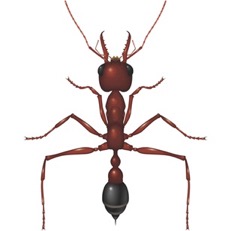
Bulldog Ant - Bull Ant
Classification
Species category: Ant
Scientific name: Lasius niger
Family: Formicaide
Description
One of the most common species of ants across the world, different members of the colony will have a slightly different appearance. Workers are dark brown-black and reach 3-5mm in length. The queens are mid brown and much larger, they can reach 15mm long.
The queen is characterised by 2 pairs of wings which are fore and hind wings hooked together. Once mated, she removes the wings and eats them for nutrition over the winter months.
Widespread across Europe, North America and Australasia
Generally, nests are located outdoors; they can be built in soil, hollowed trees, found in grasses or under paving slabs, behind fascias or any building voids. Foraging workers enter houses regularly in search of food, preferably sweet foods.
Behaviour
Black ants have defined roles within their colony. Each nest has one queen (monogenic).
- The worker ants (sterile females), build the nest, look after larvae, and forage for food.
- The queens (fertile females) remain mainly in the nest, mating with fertile males.
Before mating, the ants take to the sky. Winged reproductive males and females are involved in a mass flight. The males die after mating, but the females shed their wings and burrow in the ground where they overwinter.
Any worker ants that exhibit unusual behaviour are expelled from nest or killed.
Risks
Once inside and around buildings, they can cause various types of damage. Black Ants enjoy the sweet secretions of aphids and protect the aphid population, in doing so, they allow the aphids to further damage the plants they inhabit.
These ants can cause structural damage by shifting the foundation sand and create uneven patches and even holes in turf by moving soil underneath.
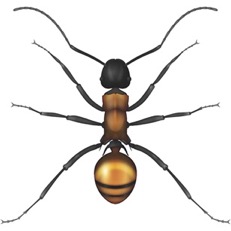
Golden Tailed Spiny Ant
Classification
Species category: Ant
Scientific name: Polyrhachis ammon
Description
One of the more eye-catching species, it has a black body with a thick covering of fine golden hairs which produce an attractive metallic sheen.
An adult typically reaches 6-8mm in length and has a pair of strong horizontal spines on the propodeum with another pair on the petiole.
They are particularly prevalent in coastal areas stretching from Queensland and right down to Victoria.
Common in forests and woodlands where it nests under trees and shrubs, it can also be found under rocks and logging or log storage areas.
Behaviour
This species is an omnivore and will forage for sugars including pollen and nectar but will also seek proteins and oils.
Risks
More of a nuisance than a risk, they tend to be secondary pests, protecting sap sucking insects for their sweet secretions. In doing so, they encourage these pests to wreak havoc on the plants they inhabit, devastating some crops in commercial agriculture and also in a domestic setting.
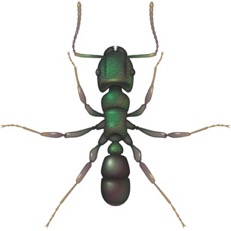
Green Headed Ant
Classification
Species category: Ant
Scientific name: Rhytidoponera metallica
Description
One of the most common ant species in some parts of Australia, these pests have a dark, metallic colouration varying from a green-blue to a green-purple sheen. Typically, they reach 5-6mm in length and have a very distinctive square shaped single node on pedicel.
This species has a widespread distribution across Australia.
They are soil dwellers when nesting and can be found in urban as well as rural locations where they may inhabit woodlands, grasslands or even lawns.
Nests can also be found under rocks and logs.
Behaviour
An attractive insect with a metallic sheen, they are known for their sting, their nests can often go unnoticed until someone encounters them and gets stung.
These scavengers primarily hunt for proteins and oils. They are also predators of smaller insects and will happily live on the sweet sticky secretions of aphids and other sap sucking insects.
Risks
The Green-headed ant has a sting that can be painful and in some humans can cause an allergic reaction. Multiple stings could lead to anaphylactic shock.
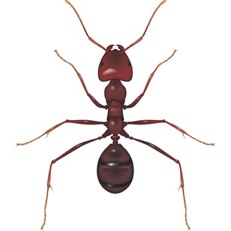
Meat Ant
Classification
Species category: Ant
Scientific name: Iridomyrmex purpureus
Description
The Meat Ant which is also commonly known as the Gravel Ant is a large ant species which reaches 13-14mm in length. It has large mandibles. Typically red and Black in colour, its compound eyes are located high on the head away from the mandibles and they have a single prominent node on their pedicel.
They are distributed widely throughout Australia.
Underground nest dwellers, this ant species has been known to create ‘super-colonies’ which occur when a queen and a number of its nest sharing ants, leave the original nest and start a new colony in close proximity, this process is called budding.
The ‘super-colony’ can have an extraordinarily large population that reaches tens of thousands of ants. Each nest in the ‘super-colony is linked through a series of trails and pathways.
Behaviour
Typically omnivores, they can eat proteins and will occasionally eat sugars from natural sources. They are excellent scavengers and unlike other ant species will actively forage during the day.
Usually, they can be found close to or connected to, an easily recognisable nest thanks to the presence of stones or gravel used to cover up the opening of the nest. They can be aggressive and will go to great lengths to protect the nest from intruders. Yet, they do not have a sting and instead attack with their strong mandibles. They have also been known to start wars with neighbouring ant colonies.
Risks
More of a nuisance than a pest, they can create large colonies in the soil which can displace turf and destabilize paving. They do not have a sting but can attack with their large biting jaws and will do so en masse which can be intimidating for the victim.
They also excrete a pungent odour which can be strong when involved with a mass infestation.
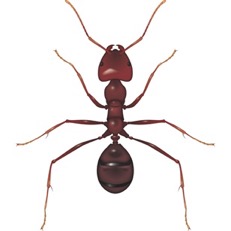
Odorous Garden Ant
Classification
Species category: Ant
Scientific name: Iridomyrmex spp.
Description
Black in colour, this ant species produces a distinctive and pungent odour when crushed. Typically, an adult will reach 4mm in length. They have compound eyes placed relatively high on the head away from the mandible.
They are sometimes confused with the Argentine ants but differ in colour and odour when crushed.
A native Australian species, they are now widely distributed across all states.
They can build their nests outside under stones but can also be found in wall cavities, they often only come indoors in search of a water source.
Behaviour
Typically omnivores, they can eat proteins and will occasionally eat sugars from natural sources, particularly for the moisture component. This species can be aggressive and are excellent scavengers.
Risks
More of a nuisance than a pest, they can create large colonies in the soil which can displace turf and destabilize paving.
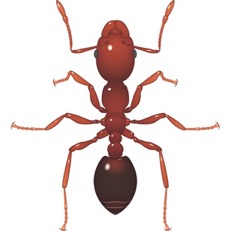
Fire Ant / Red Imported Fire Ant
Classification
Species category: Ant
Scientific name: Solenopsis Invicta
Family: Formicidae
Description
The Red Imported Fire Ant (RIFA) has a copper brown head and darker, reddish-brown body. The average worker ant reaches 2-6mm in length and it has strong mandibles with 4-5 distinct teeth. It has a distinguishing 2-part pedicel and its body is covered in numerous erect hairs.
A native of South America, the RIFA is now found in Queensland, Australia and pose a threat to the environment.
Typically, they build their nest underground in mounds. The mounds are found in lawns or disrupting turf and have no obvious opening at the top. The RIFA is often discovered when someone inadvertently steps on a mound and they launch an attack.
Behaviour
Often congregating in massive colonies, this pest is small but incredibly aggressive and considered one of the most hostile of all ant species. Under threat of attack, they will launch a coordinated attack on their victim.
Colonies can have single or multiple queens and they can reproduce at a very fast rate. Their diet is generally organic matter but they will also invade the home looking for sweet products or other protein-rich foods.
Risks
Most feared for the painful attack launched when threatened, the RIFA has a persistent sting that leaves a white pustule. Even though they bite, it’s the venom of the sting that causes the residual pain and pustule.
Under attack, they emit pheromones which prompt other members of the colony to launch a synchronized attack. A multiple attack is incredibly painful and some victims can suffer an allergic reaction.
The mounds can also be a nuisance, disrupting root growth and disturbing plant formation which can result in lower yield crops and patchy turf growth.
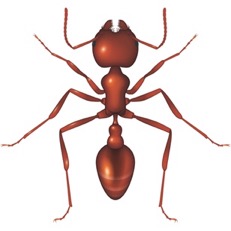
Seed Harvester
Classification
Species category: Ant
Scientific name: Pogonomyrmex barbatus
Description
This species is usually red in colour and bears a resemblance to the fire ant but is not related to the fire ant species. The average size of a worker ant is 6mm; they are considered a large ant species.
Seed Harvester ants are found throughout Australia.
The nest tends to be deep underground and is often indicated by a small opening and a distinct lack of vegetation in the surrounding area. Due to a preference for grass seeds and exposed, open spaces, turf can be an ideal nesting spot.
Behaviour
Commonly also known as the Red Harvester Ant, this insect’s name derives from its preference for taking seeds into the nest and storing them. Seeds are their staple diet; they gain all nutrients from them and hoard them in great numbers. However, they will also eat other dead insects and spiders. An established colony can have 1000s of ants.
Worker ants forage for seeds each day, leaving a chemical trail that leads back to the nest.
Risks
Serious infestations can destroy turf, creating large uncovered patches with tale-tale collections of soil and tiny pebbles around the nest opening that are displaced by the workers during nest building. They also destroy grazing available for livestock.
The Seed Harvester Ant is not generally an aggressive insect but does have a powerful and painful sting that it administers when it perceives that the nest is in danger. Worker ants protect the entrance to the nest, as the nest itself will be deep underground
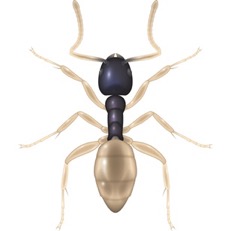
Ghost Ant
Classification
Species category: Ant
Scientific name: Tapinoma Melanocephalum
Family: Formicidae
Description
Very small ants, the workers are 2mm long and have a pale, almost translucent abdomen and legs, hence the name. The head and thorax are a deep brown colour. The almost transparent body makes these tiny ants look even smaller again.
Found all across the world, they are one of the most widely distributed ant species.
Ghost Ants tend to prefer warmer, wet habitats. Colonies are generally located outside but there are also colonies that set up home inside. Indoor Ghost Ants select their habitats based on their preference for warmth and high moisture requirements. Their trails often lead to sinks, baths, toilets and showers.
The nests are frequently located within wall voids, behind skirting boards, or in potted plant soil. Workers run rapidly and erratically, trailing along edges and corners.
Behaviour
It’s an invasive species that forages for all kinds of nutrients and will live on grease and other insects but favours sweet foods. Ghost ants have polygene colonies (multiple queens in a single colony) with individual nests containing between 100-1000 workers. One colony may consist of several nests which readily exchange workers.
Risks
This ant’s love of sugary substances attracts them to the sweet secretions of aphids, which they protect and in doing so, allow the aphids to continue to destroy the plants they inhabit.
Indoors, they contaminate household foods by attacking any sugary items such as cakes, chocolate, sugar etc…
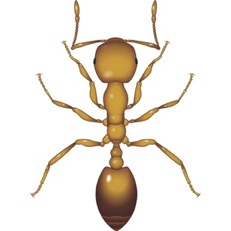
Pharaoh Ant
Classification
Species category: Ant
Scientific name: Monomorium pharaonis
Family: Formicidae
Description
This small ant is yellow-brown in colour with well-developed black eyes. Workers tend to be 1.5-2mm long, while the male is slightly larger at 3mm long and is a darker black colour with wings. The Queen is 3.6-5mm long, she is dark red and winged.
Widely distributed across Australia, they need warm, humid conditions which mean that in temperate lands they are confined to buildings and often found infesting hospitals.
Infestations are discovered in a wide variety of locations including residential blocks, hotels, hospitals, zoos and on board ships. In warmer climates, infestations can even be found outside.
The insects locate themselves in the fabric of buildings (wall voids, windows etc.) or in plants and sterile supplies. They can spread through service ducts (e.g. heating and electrical conduits). The ants forage for water around sinks and areas of condensation.
Ants forage for meat, cheese, fat, sugar, honey, jam etc. In hospital, they will feed on blood and intravenous diet fluids. Dead insects, mice and droppings can also provide a food source.
Behaviour
There are several queens in one nest (polygenic). Winged Pharaoh ants do not fly. The queens are interchangeable, so colonies survive indefinitely. Disturb, rather than destroy the nest, and there is a strong likelihood that you will encourage a new colony.
These social insects live in colonies from a few dozen to 300,000 ants. The ants can survive low temperatures for prolonged periods where the workers continue to forage for food.
Risks
Materials are often damaged by the ant’s constant chewing with their strong mandibles. They can even penetrate the plastic bags containing sterile dressings and instruments.
Pharaoh ants pose a risk to health as pathogenic organisms can be transmitted when the ants feed in unhygienic places including drains, bins or even wound dressings.
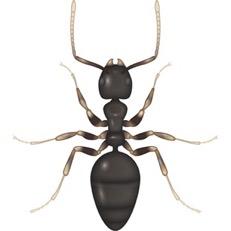
White Footed Ant
Classification
Species category: Ant
Scientific name: Technomyrmex Albipes
Description
A small, dull, and cloudy-black coloured ant which can reach up to 3mm in length during adulthood. It is distinguished by the pale colouration on all of its tarsi and antennae which are a whitish-yellow colour. Unlike the Common Black Ant, it features a single petiolar node which is hidden and has 12 antennal segments.
Present all across Australia and in many parts of the world, these ants are native to tropical Asia.
Nests are more commonly located outdoors and there are often additional nests in close proximity. These new nests are created by the process of budding, where a selection of male and female ants leave the original nest and start a new colony.
Nests can be found in trees, shrubs or anywhere that will accommodate a group of ants including brick voids and behind fascias.
Behaviour
These social ants are known to create incredibly large colonies that have a range of queens. Their reproduction potential is phenomenal due to the multiple fertile members of the colony. Some colony sizes are estimated at tens, even hundreds of thousands.
The White-Footed Ant is not a biting insect and primarily exists on sugary foods, particularly honeydew and occasionally proteins. Workers from this trailing species are very prevalent when foraging, as they can exist in large numbers.
Risks
Seen more as a nuisance rather than a pest, these ants are troublesome because of their large colonies and constant foraging in kitchens, bathrooms and the exteriors of buildings.
Agricultural and crop damage is often worse in the presence of White-footed ants as they protect aphids and other bugs in order to feast on their sweet secretions. Protecting these bugs, allows them to destroy the plants they inhabit.
Contact us at Redknight –Pest Control Experts in Ant extermination in Melbourne, Ballarat and Geelong.
All treatment comes with warrantees.


